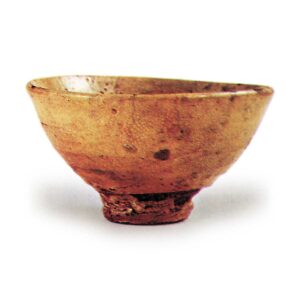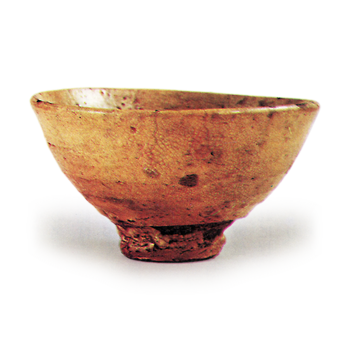
National treasure.
A great masterpiece.
Korean tea bowl,
Famous hand well. Also known as the Honda Well.
It was owned by Takeda Kizaemon, a merchant in Osaka during the Keicho period (1596-1615), hence the name. Later it was handed down to Honda Notomori Tadayoshi, so it is also called Honda Ido. The outside of the potter’s wheel is loquat colored with some bluish tints, and there are some fire holes on the body. There is a long, narrow carp-shaped mending. The wheel stands firmly around the base, and more than half of it shows the clay. The high base has high bamboo joints, and some of the rim surfaces are irregularly thick and thin due to rubbing. The inside of the stand is rather deep, with rough kairagi bumping into each other, and the center of the stand is sharply pointed. The general workmanship is very tough, and the areas where the clay is visible inside and outside of the base and the areas where the Kairagi has adhered are intermingled, making this a tea bowl with an unparalleled tea flavor. The inside of the bowl is loquat colored with a yellowish hue, and there is no eye, but there is a conspicuous wheel-thrown pattern on the half of the bowl. The glaze is interesting, the prospect is deep, and the wheel-thrown eye is sharply turned in the center. The interior has few views, but it is probably because the workmanship around the base is exceptional that it has become famous in this age. There are several small lacquer repairs on the mouth rim and a few short vertical gutters, but there are no major cracks. It is thought to be the oldest work among Koryo ware. This tea bowl was dedicated from Takeda Kizaemon to Honda Notomori, and in 1634 (Kan’ei 11), when the Honda clan was transferred to Yamatokoriyama, it was given to Nakamura Sosetsu, a well-known businessman in Sennan, and in 1751 (Kan’en 4), it became the possession of the Tang clan. It is a specialty of Japan. He ordered his successors, “It is a masterpiece of the world and should be treasured for a long time. However, it is said that the owner of this tea bowl had a history of tumors and that Fumi also became ill with a tumor, so his wife Pengrakuin advised him to part with it, but Fumi was still regretful and did not agree. After Fumai’s death, his son Gekitan also became ill with a tumor, which caused Rakuin’s concern, and in the first month of 1822, he donated this tea bowl to Kohoan in Kyoto as an alms for the return of Shirobe Yanagida, a retainer of the family. There have been many different theories about the legend of this tumor since ancient times. According to the legend of the late Edo-period scholar from Izumo Province, the original owner lost his fortune and became a resident of Shimabara, Kyoto, but he still kept it in a sack around his neck for the rest of his life. When the “Fumi” asked for it, some of his subjects admonished him, but he purchased it without any concern. (Kokin Meibutsu Ruiju, Shouke Meibutsu Shu, Unshu Goshu Gochuppai Ki, Meibutsu Shu, Matsudaira Fumai Den, Taisho Meikikan, etc.)


